GDE 710
WEEK 12
New steps
Finally the last week! This week begins with an inquiry into what the future holds and what it means for the design practice, the industry, changes that may occur and how design that works in one medium or context can be redefined or reimagined in another context or paradigm. The conversation begins by speaking to our design practitioners. The main questions of inquiry this week are:
How is perception changed when design shifts into a new paradigm?
Future Definitions & Changing Sectors

Idea is the central thing. So, while there's a lot of change going on and things that are accelerating all the time, actually, as much as things are changing, they’re staying the same. That's because, it's all aimed at people in the end and if we can't connect well to people then ultimately, we are failing in our projects.
Simon Manchipp
What are potential future definitions of design practice?
All of the practitioners shared different prespectives, all of them shared the opinion that design is becoming more versatile and that designers of today need to be multi-skilled and be able to crossover domains. It was understood that this is because even client asks in the current day and age are not limited to designing one piece, like "I need a business card designed," clients are looking for ideas and experience and how to translate things into various ways of telling a story, often across various media. Design is itself getting broader it is not contstrained to strict craft anymore and technology is fastly causing that evolution.
I was also left with the idea of 'attention economy' and how the audience is looking for an experience. If designers can differentiate and engage the audience they can turn them into loyal brand advocates. Although technology and globalization have caused more of the same stuff to show up everywhere, if designers differentiate by creating well-crafted, thought-out and beautiful stuff they will break through the noise.
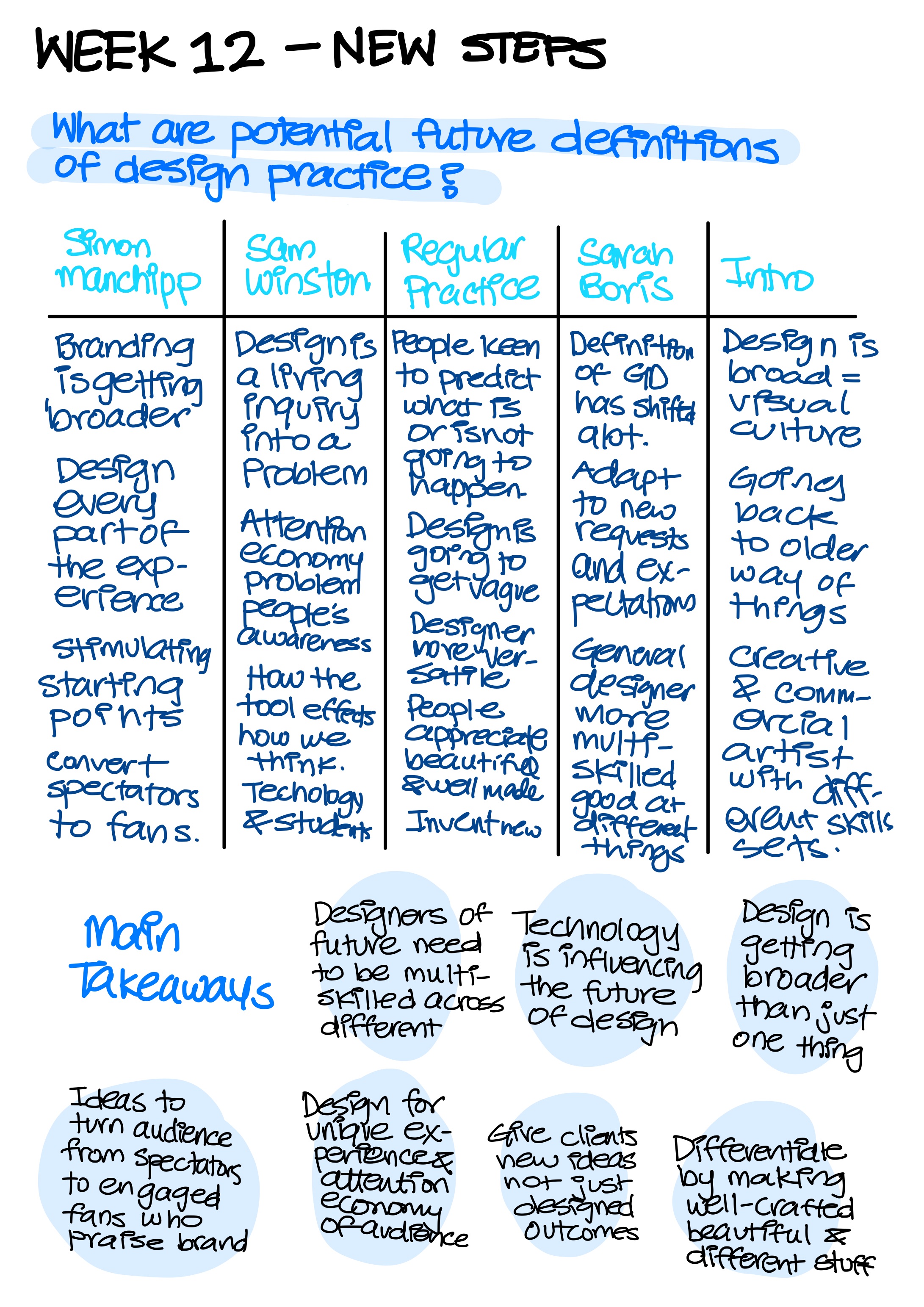
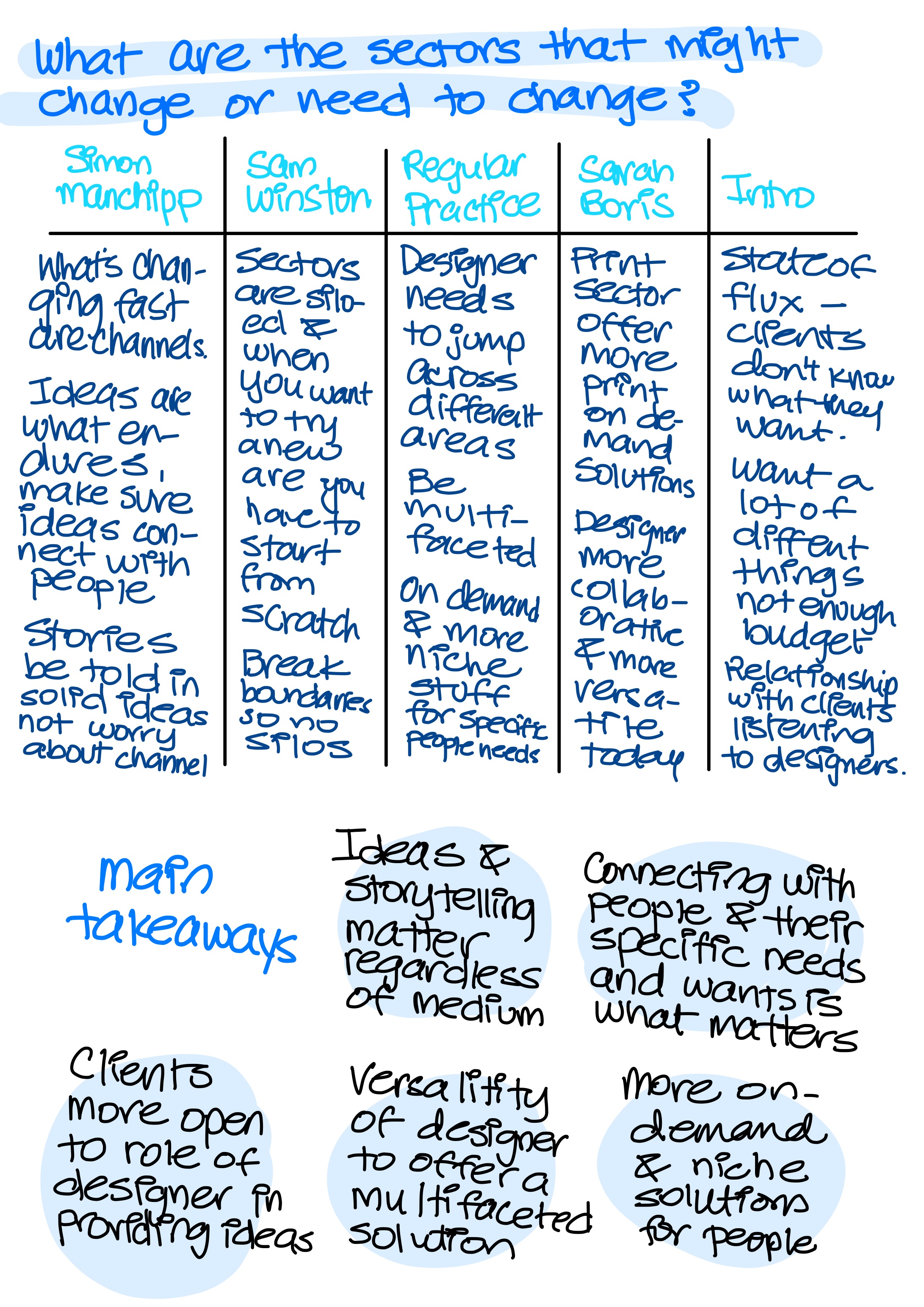
What are the sectors that might change or need to change?
The print sector stood out as one where more on-demand solutions are emerging. I can see this with a lot of self-publishing and even scenarios where you upload a book and for example Amazon takes care of the printing for your customers. Ideas and storytelling are timeless, and the strongest asset a designer has no matter what the medium or channel of delivery, a well told story or a solid idea can make any sort of execution shine. Clients are learning these days and want more ideation and thought-based advice from designers and are willing to listen.
Channels are what is changing most in the landscape as technology advances. We saw the rise of Facebook, Instagram, Twitter and Tik Tok. We are know soon entering into a world where notions like the 'metaverse' and a fusion of reality with virtuality are on the horizon. This means that designers will have to have more skills under their belt and will likely start learning coding for example. So versatality will be very important to be successful in coming up with varid solutions. It may also mean not going it alone and crossing over to other domains and collaborating. Audiences, consumers are looking for more customized solutions which meet specific needs so really focusing in on niche solutions are what will make a designer successful.
New Steps Podcast

I think one of the fundamental things about design, and what we do in graphic designer, is that we’re in the optimism business. I think we believe that we can make the world a little bit better and I think, if you don't believe in that then you should stop designing straight away.
Maziar Raein
Listening to Susanna's and Maziar's podcast was as usual a treat. I love how I get to be a spectator to their conversation and how they both converse in an easy way and one idea emerges and then another organically. My way of taking notes this week fascilitated learning by chunking together the main themes that came up by colour, and in capturing these thought-bytes in a concise form.
I uncovered a few themes in the conversation:
GREEN referred to ideas, knowledge, their perception and communication. How in new environments and contexts ideas can be preceived differently and so what becomes important is looking at language and seeing how different languages exist around an idea or notion and then altering or creating a new one.
YELLOW referred to notions of knowledge vastness, knowledge gaps, what can I do vs, what can we do? How different people bring different and more knowledge to the table than just me alone. And how problem solving is about collaborating and sharing ideas with different people and experts and coming together to solve problems.
BLUE focused on themes of intellect, how complex or simple things are, how complex things can become the more you entangle with them, how one can approach problems with intellect, critical thinking and conceptualization and create a process, break out of what we know and create new things.
ORANGE focused on the notion of craft, and a designers tools and toolkit, craft defining the way a designer works in a non-thinking way. Having a tacit, physical and embodied knowlege to practice and design. This idea of using new tools like a smart phone, to curate and collect and build visual references, materials, visuals, sounds, build our own knowledge collections for referal and recall to problem solve.
PINK tackled the intuitive elements that make us designers the notion of caring about something, believing you can make the world a better place, tapping into your own sensibilities, and reflection on what makes something personal and meaningful to you.
Purple was a lone point about the tension designers experience between work they do for themselves and work they do to earn a living.
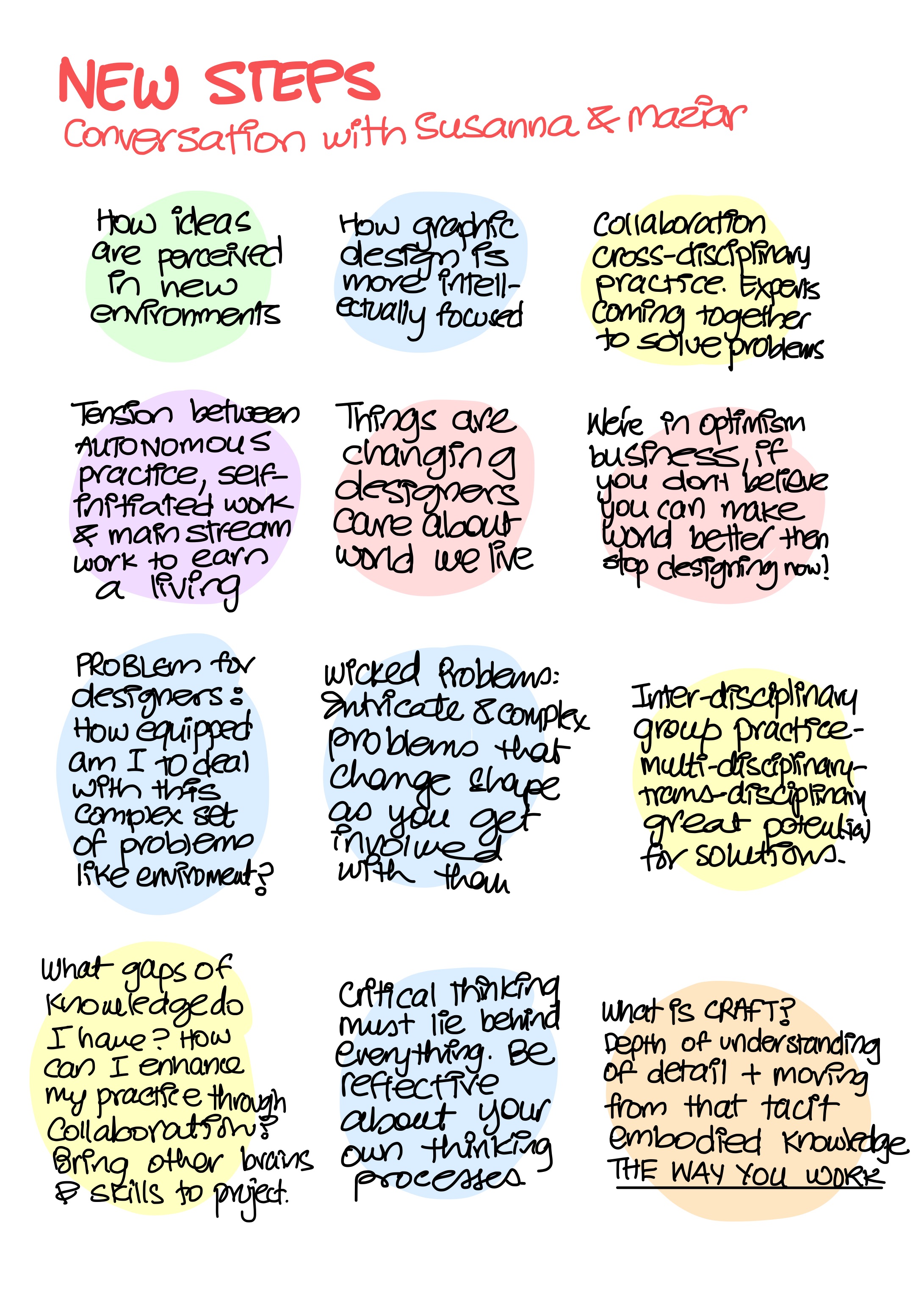
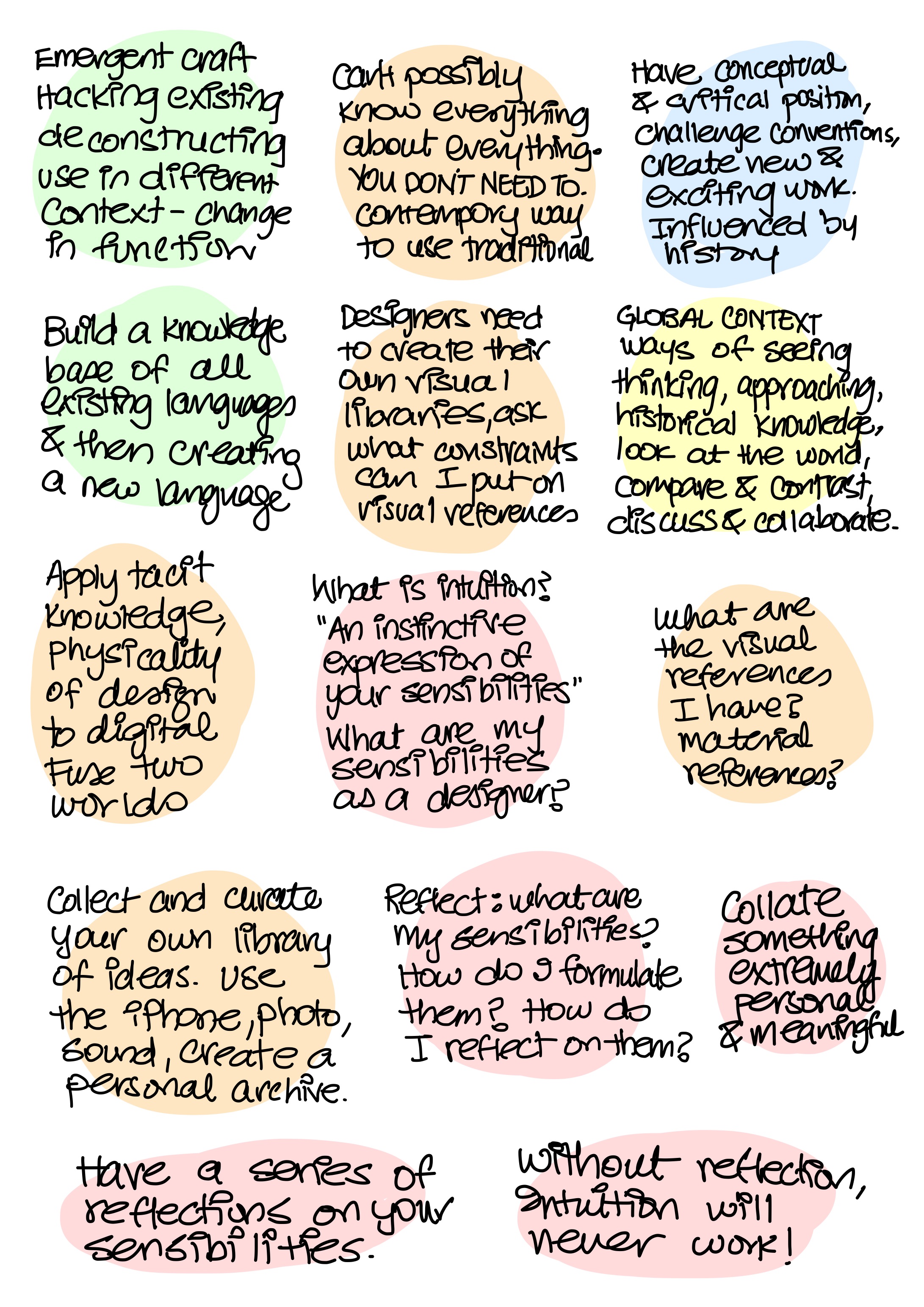
From both lectures I decided to think about meaningful issues and how to create a better world and solutions for future products in a new paradigm. This became my springboard for the challenge.
Anab Jain: Why We Need to Imagine Different Futures

I spend a lot of time thinking and creating visions of different futures in our studio. We are constantly looking out for weak signals, those murmurs of future potential. Then we trace those threads of potential out into the future, asking: What might it feel like to live in this future? What might we see, hear and even breathe? Then we run experiments, build prototypes, make objects, bringing aspects of these futures to life, making them concrete and tangible so you can really feel the impact of those future possibilities here and now.
Anab Jain
I was able to watch this TED talk by Anab Jain from the resources and it helped me come up with the idea for the weekly challenge. This idea of imagining a future solution to design for the future world based off of a 'potential' today really spoke to me. I've always found it fascinating the way some famous old artists like Leonardo Da Vinci were versatile and had knowledge of so many fields, and also were curious and used that knowledge to imagineer future things. How Da Vinci's sketchbooks featured designs for example for flying machines, and war machines. While watching this TED talk I was reminded of this and how one can come up with innovative solutions if we think of a future context or paradigm to design. So my challenge this week speculated an idea for the future.
Workshop Challenge
CHALLENGE: Take a graphic design interest that you are familiar with and investigate how the idea can be improved, disrupted or retold through a shift of application. This might be an opposing media or environment (e.g from book to installation, packaging to performance) or an opposing time or fictional future (e.g. speculative design). You can tell the story of your idea in any medium, but ensure the shift you make with your project is apparent, courageous and driven by risk and a rationale.
I had many different ideas this week that I sketched out roughly on my iPad. The one I chose to go with was prompted by Maziar Raein's point when he said that if we as designers didn't believe that we could make the world a better place we should stop right now, and that we're in the optimism business. I linked this to future-based speculative design and thought about how can we make the world a better place and if I had a solution or idea for a problem as a graphic designer.
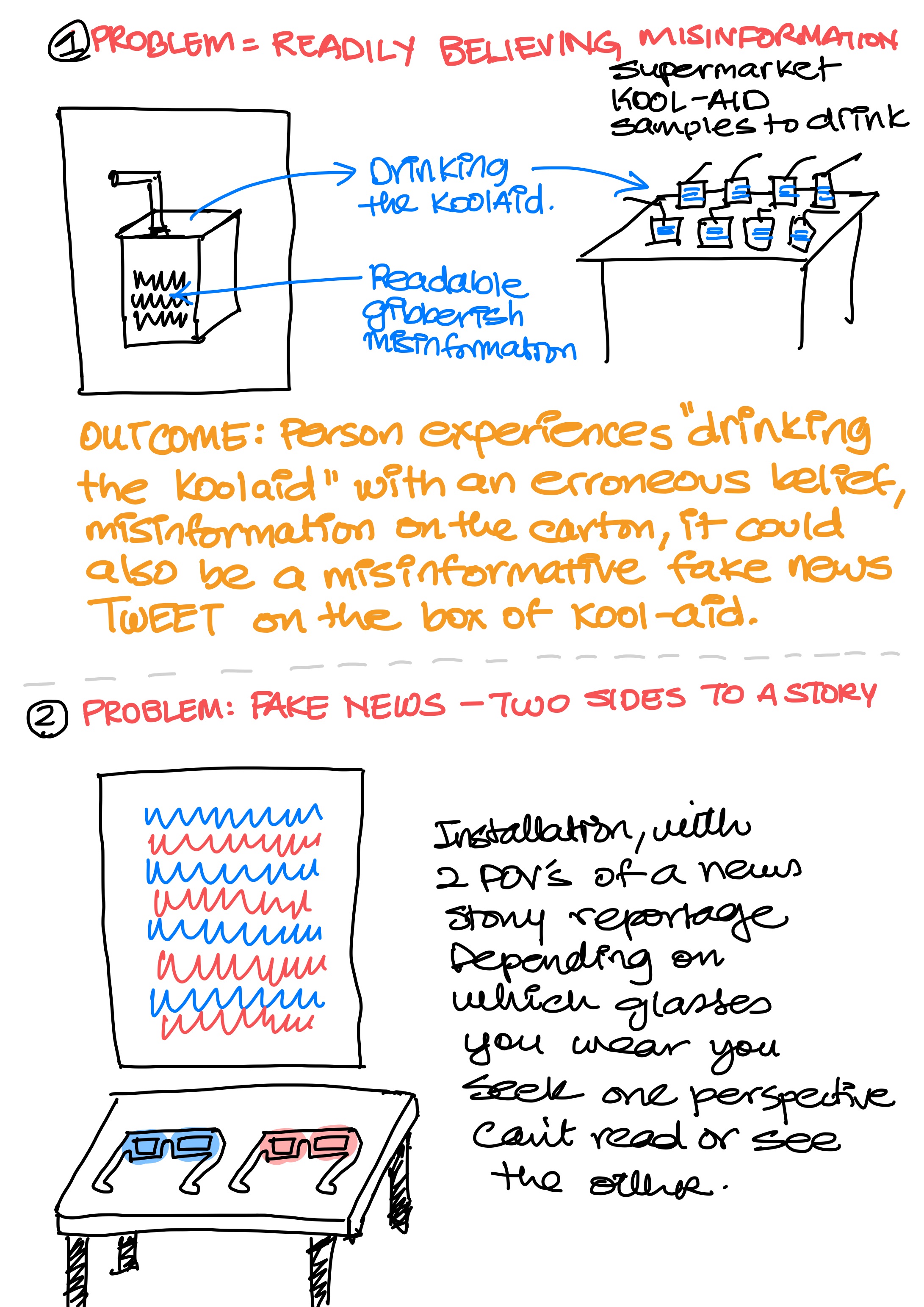

For my first 3 ideas it was a standard shift in perspective, take one thing put it into another environment to shift perception. Then I took a break and was on Instagram and I saw a CNN news story. I clicked the link in bio and found the actual story on their website. It mentioned that an 'anti-procrastination café" in Japan called a "Manuscript Writing Café" had gone viral. And I chuckled because this was like a "murmur of future potential" that Anab Jain was talking about. During the pandemic I also came across these silent Zoom calls called 'Focusmate' where you go to join another person in the world, and you both state your intention and then just work in silence for an hour. I even tried it and it was super productive focus time away from distractions of life. So I thought, why can’t we have cafés for accomplishing specific things, like a focused intention?
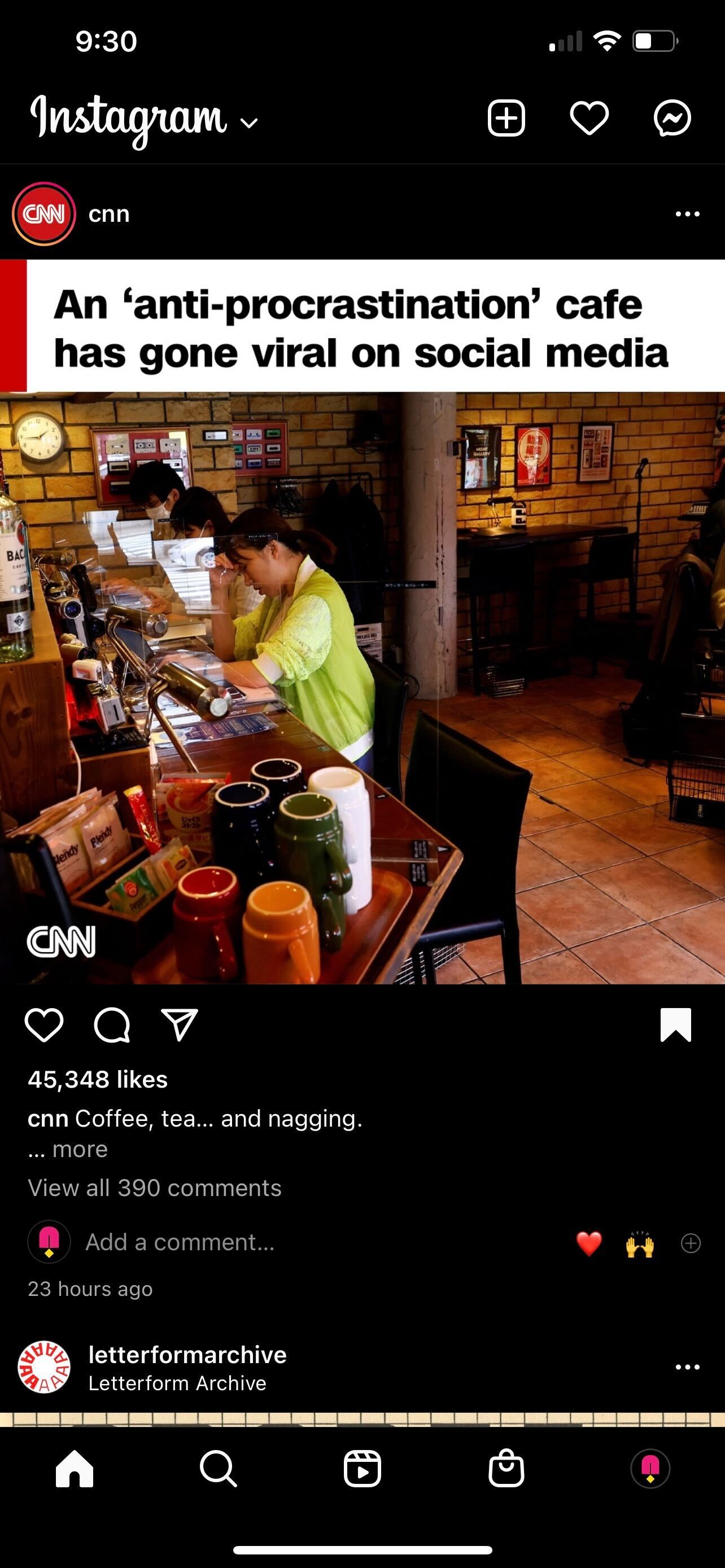
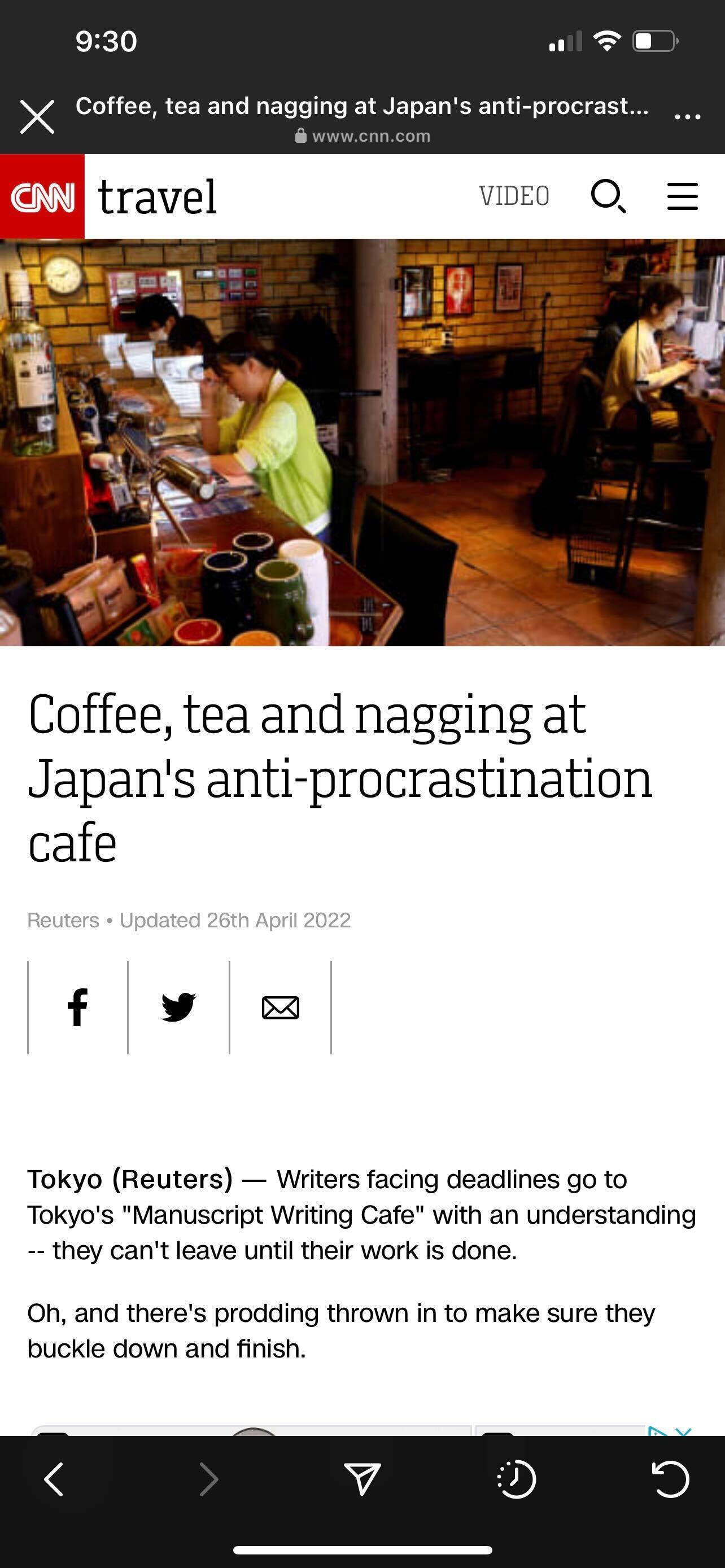
I also thought about what Maziar Raein had said about us being in the 'optimism business' and making the world a better place. So I got to thinking about a social problem in the world, also prompted by Maziar's reference to 'wicked problems' and what came to mind was mental health. I come from a South Asian family, my brother has ADHD and I sometimes experience anxiety. Cultural stigma and there being no such thing as mental health were notions I grew up with. That and living in Canada and even reflecting on research in the US, most people who suffer from mental health don't seek out help. With the pandemic it's become even more of a problem. I personally believe mental health is just like physical health and believe that access to it should not be so expensive or hard as it is in North America, and two people just look at you like there's something wrong with you.
In Canada and US we have these mental health awareness months when brands go crazy running all these campaigns. I'm not a big fan of these campaigns although I find them really creative sometimes, because I don't believe they actually solve the problem.
Here is critique on a very famous 'Let's Talk' campaign by Bell that happens every year in Canada:

Here is another famous and creative one by Burger King in the US:
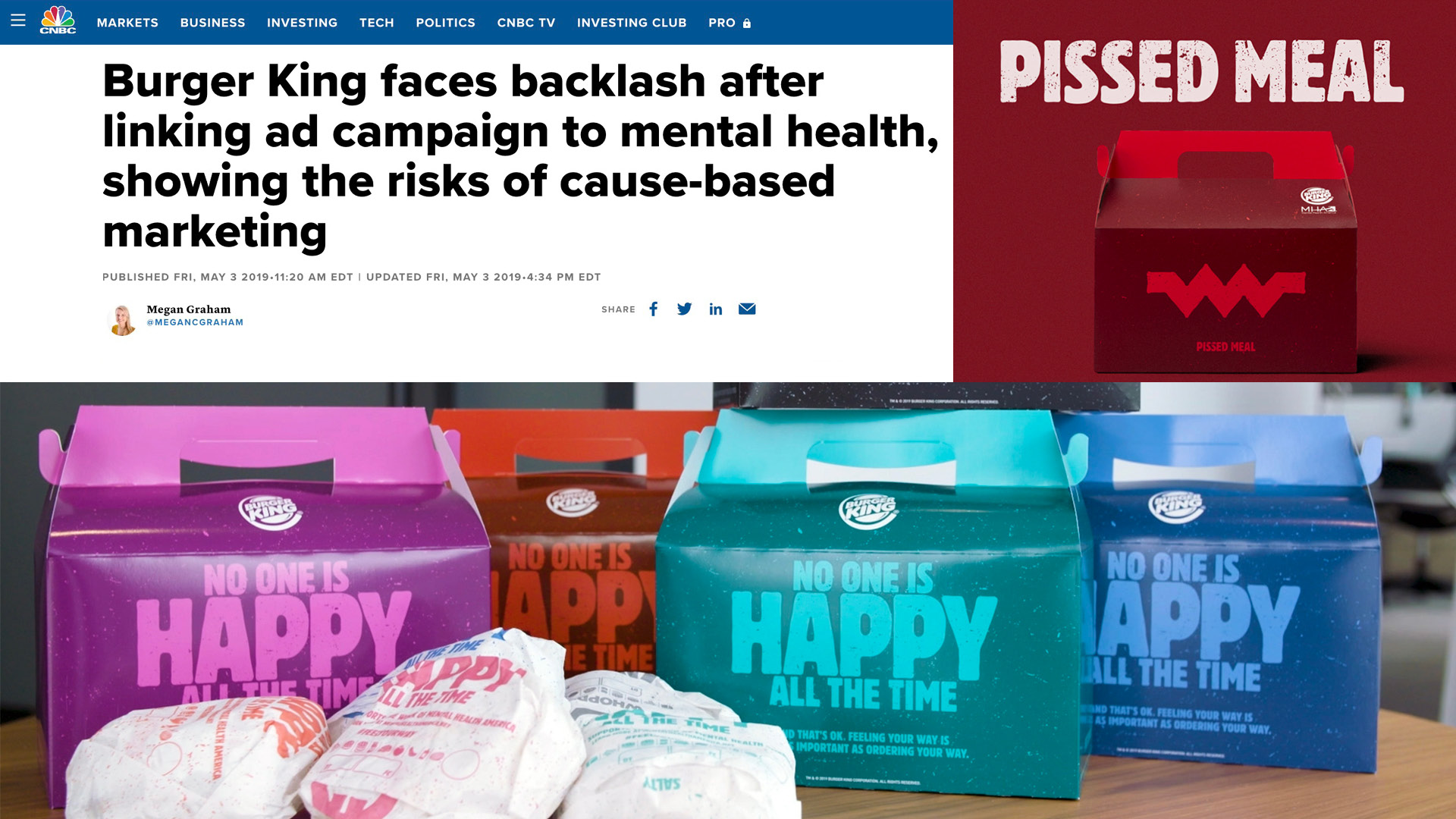
So here is what I came up with:
The Problem:
A decade ago, issues around anxiety, self-esteem, depression and suicide were taboo or simply not taken seriously. Mental health was swept under the carpet, misunderstood, not to be discussed, even mocked and that covered the spectrum from schools to employers, right through to media and policy makers in government.
The month of May is Mental Health Awareness Month in the USA. May 4 to May 10th is Mental Health Awareness week in Canada. October is Canada’s Healthy Workplace Month, and October 10 is World Mental Health day.
Mental health awareness campaigns during 'mental health awareness month', or 'day' are often run by companies and the messaging suggests raising awareness and talking about the 'problem'. The trouble with getting everyone talking about mental health, especially when brands get involved is that it's usually an idea-first and purpose-second effort.The conversation gets reduced to this level of banality. You grab the pin, the badge, the coke, or the burger, or share the hashtag, text, maybe you pledge money and donate to the cause, great, and then the campaign is over. It’s a faux-woke approach to social consciousness. It becomes a hollow shell for shameless self-promotion and virtue signalling. It often doesn't help those who it aims to help.
It can be argued now that the purpose of ‘awareness raising’ is over. What is required now is action to deal with the problem. For a person suffering from a mental health issue, who can’t or won’t seek out help, what purpose do these campaigns serve?
The Solution:
Speculative Future Design
CALM CAFÉ
Creating a space for everyone. No us (normal people) and them (suffering from mental health issues). Everyone has emotions, and everyone has bad days, everyone has mental health just like physical health. Go to a Calm Cafés whenever you need a change of mind, want to self-soothe, talk, be alone. Like going to a gym for a workout, or a library to study, or a coffee shop for some quality me-time, or a salon to get a haircut.
A safe, minimal, calm space to unwind, breathe, and get resources for mental health help if you need them without anyone knowing if you don’t want them to.
Calm Café is like any other café but it’s like a buffet. You can get a membership. Or just pay for a visit. There is no barista serving you. Its all self-serve. You choose your pick-me-up product—maybe it’s a ‘nice cream’, a ‘clari-tea’, a ‘sentimental soda’, or some ‘cheerful chocolate’. Stay as long as you want and recharge and feel better.
Products have smart design and if you want you can use augmented reality with your cellphone to learn more about what you’re feeling, take a test, access support, or even be referred to a therapist if you choose to, and no one is the wiser, and you’re empowered to get the help you need if you need it. Otherwise just enjoy the mindful moments away from other stressors in life.
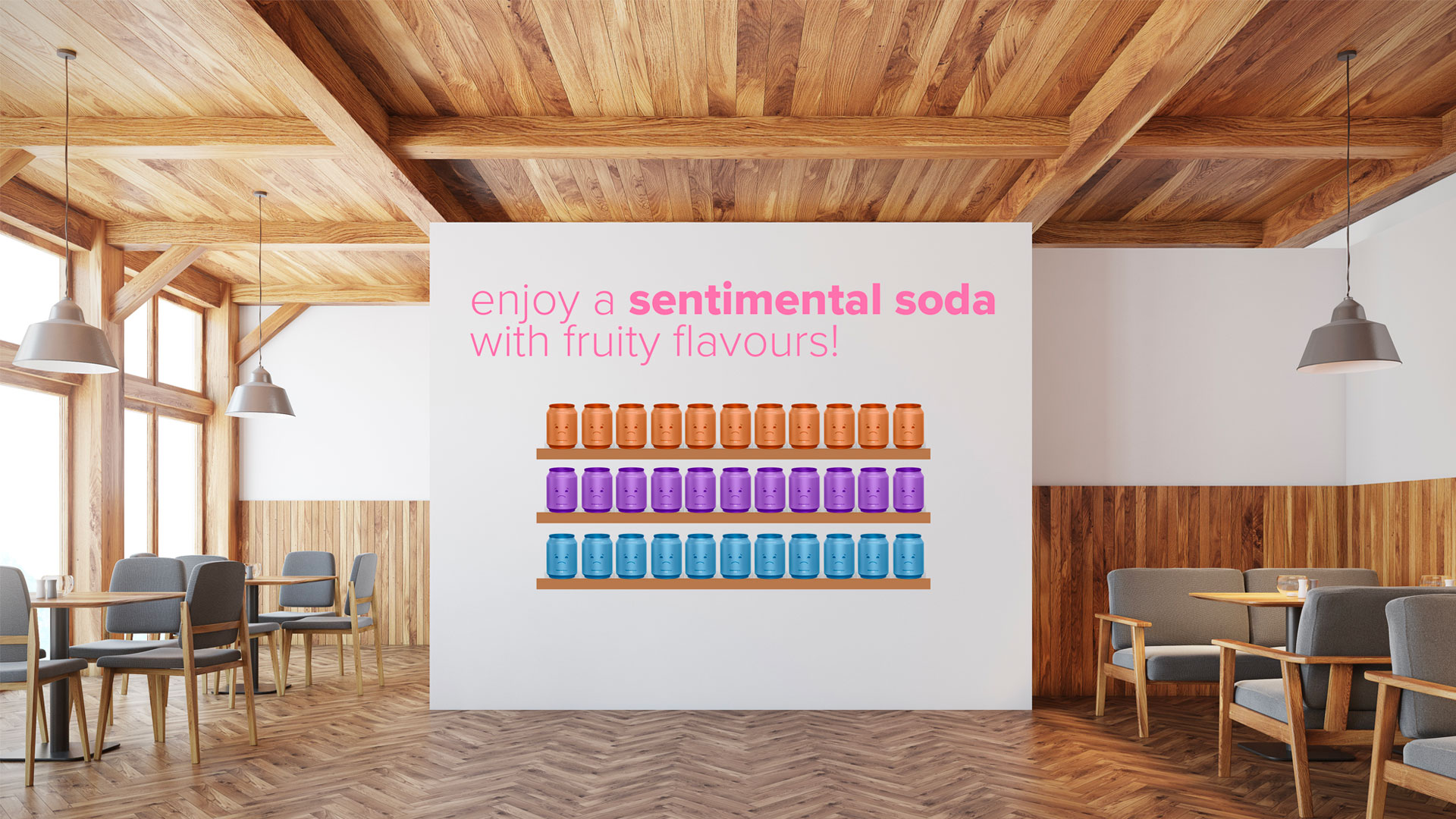


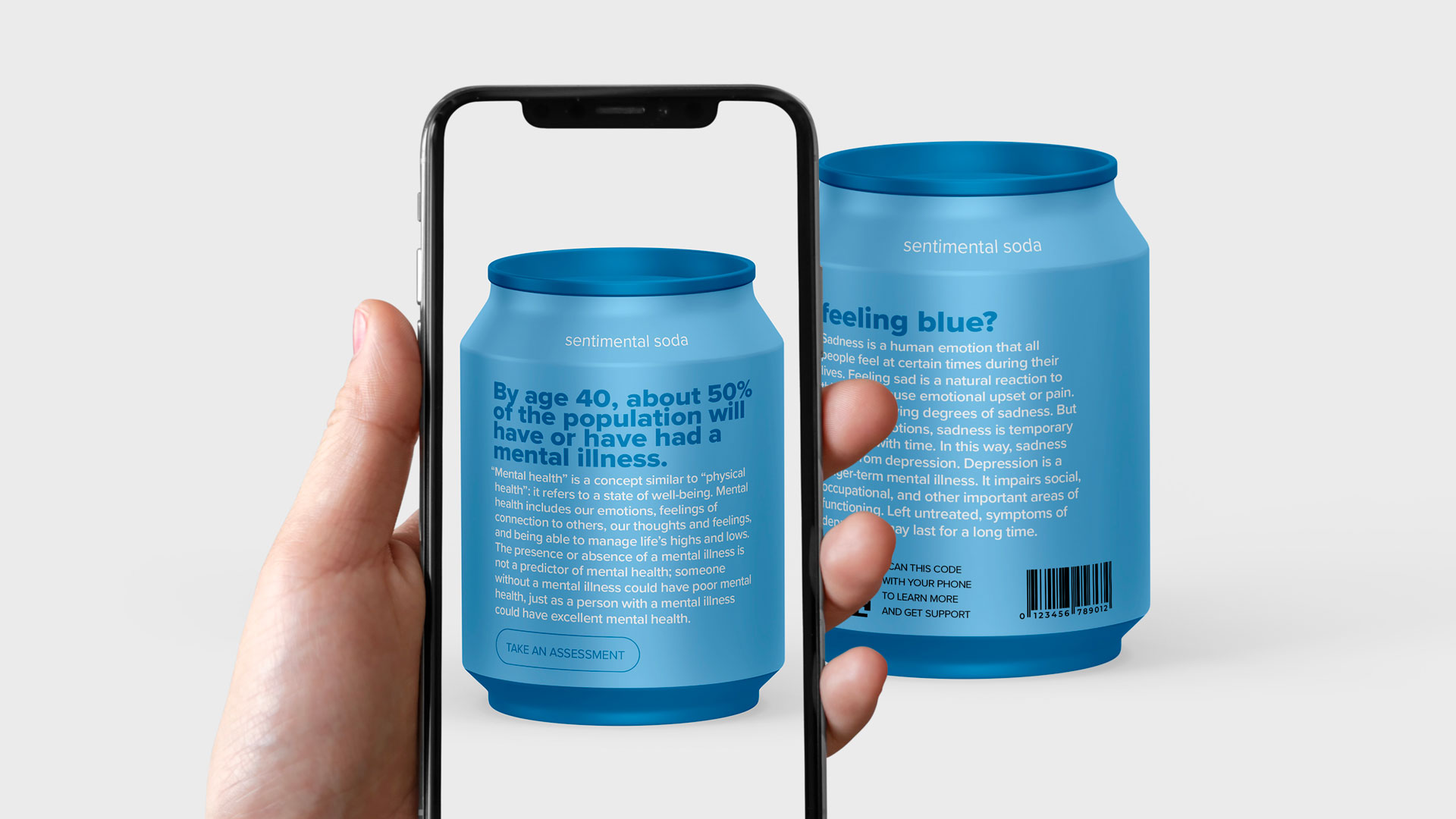

Ideas Wall
Here I share my cocontributions to others on the Ideas Wall, and comments left by others on my challenges.
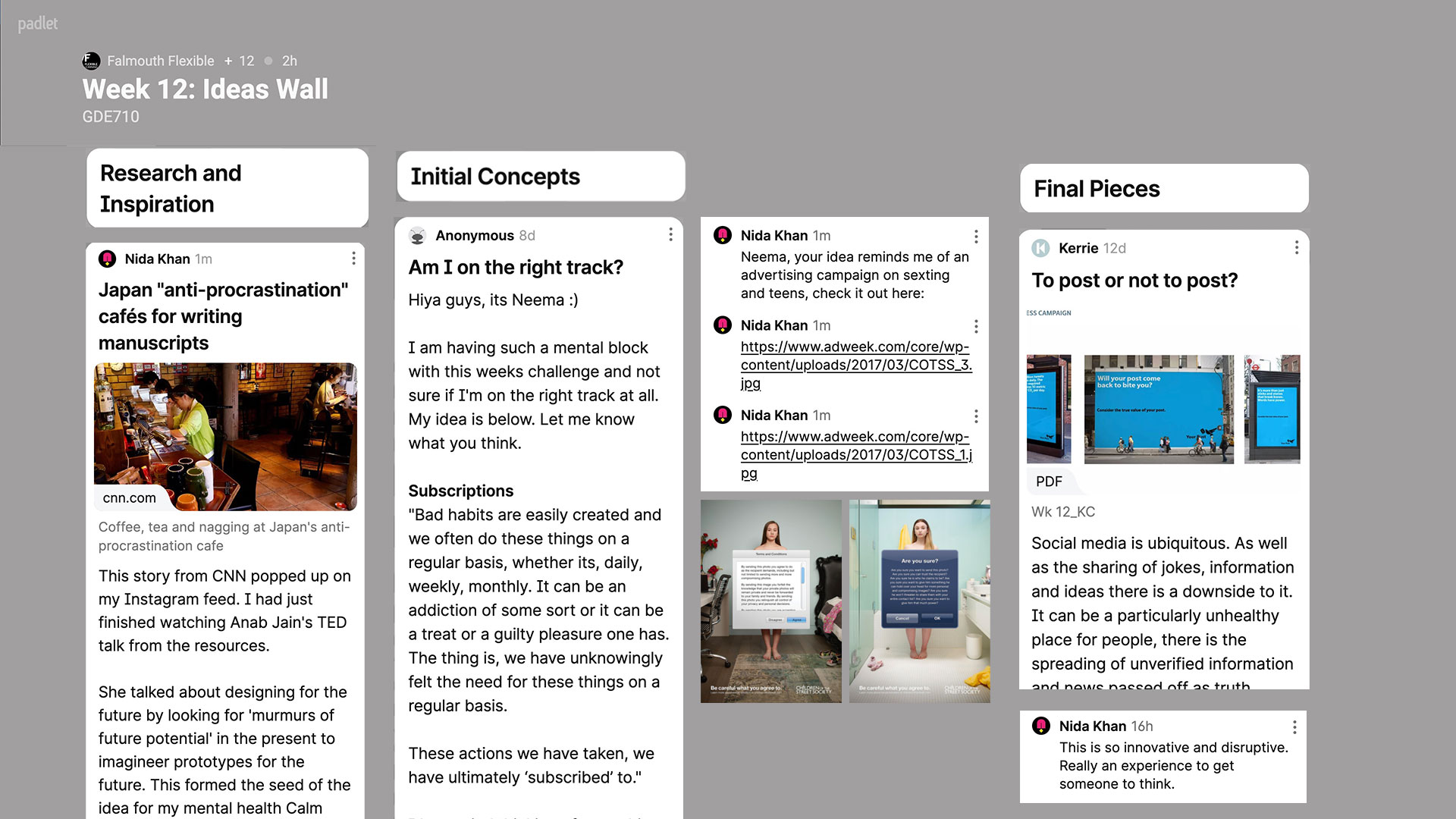
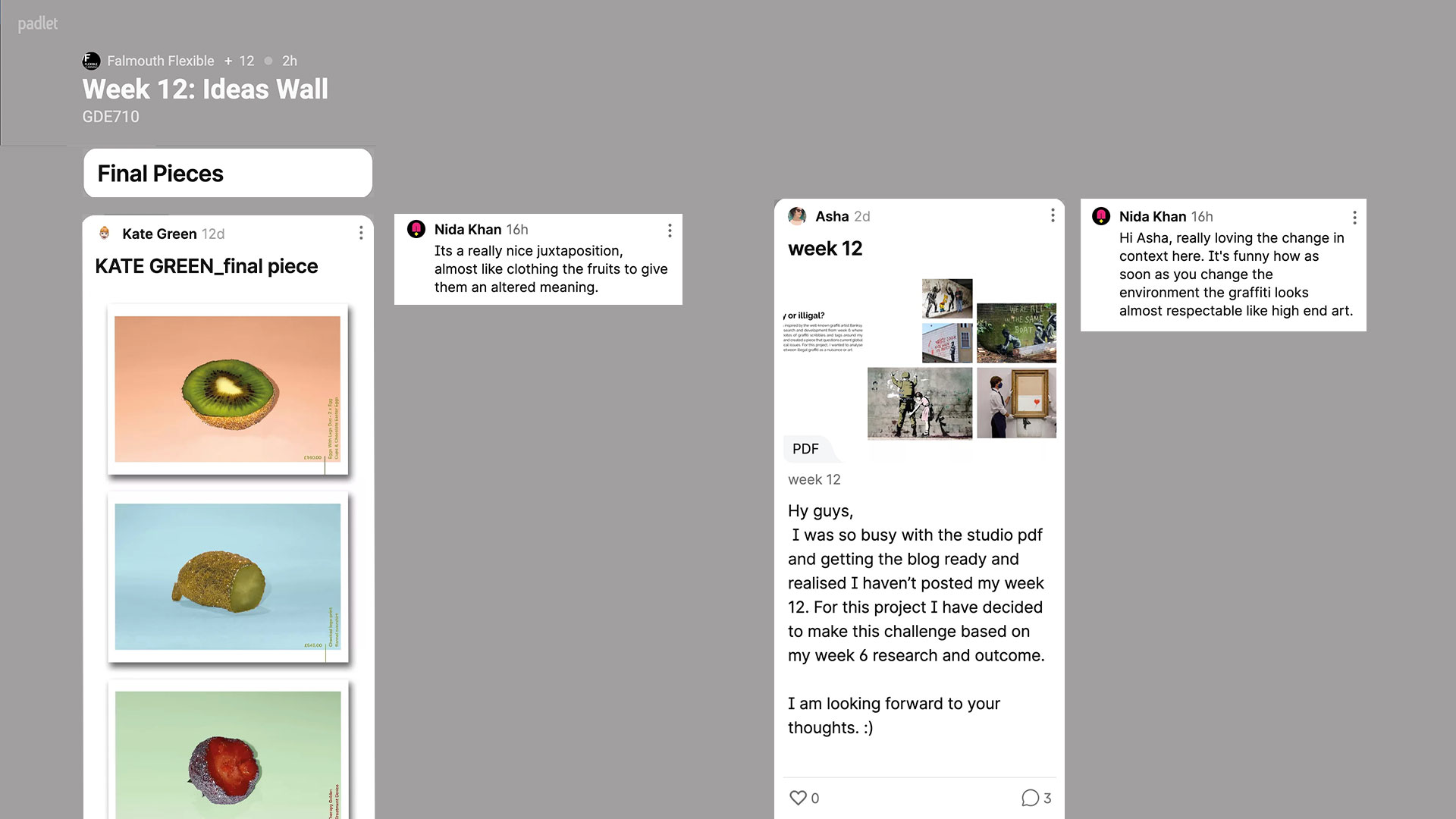
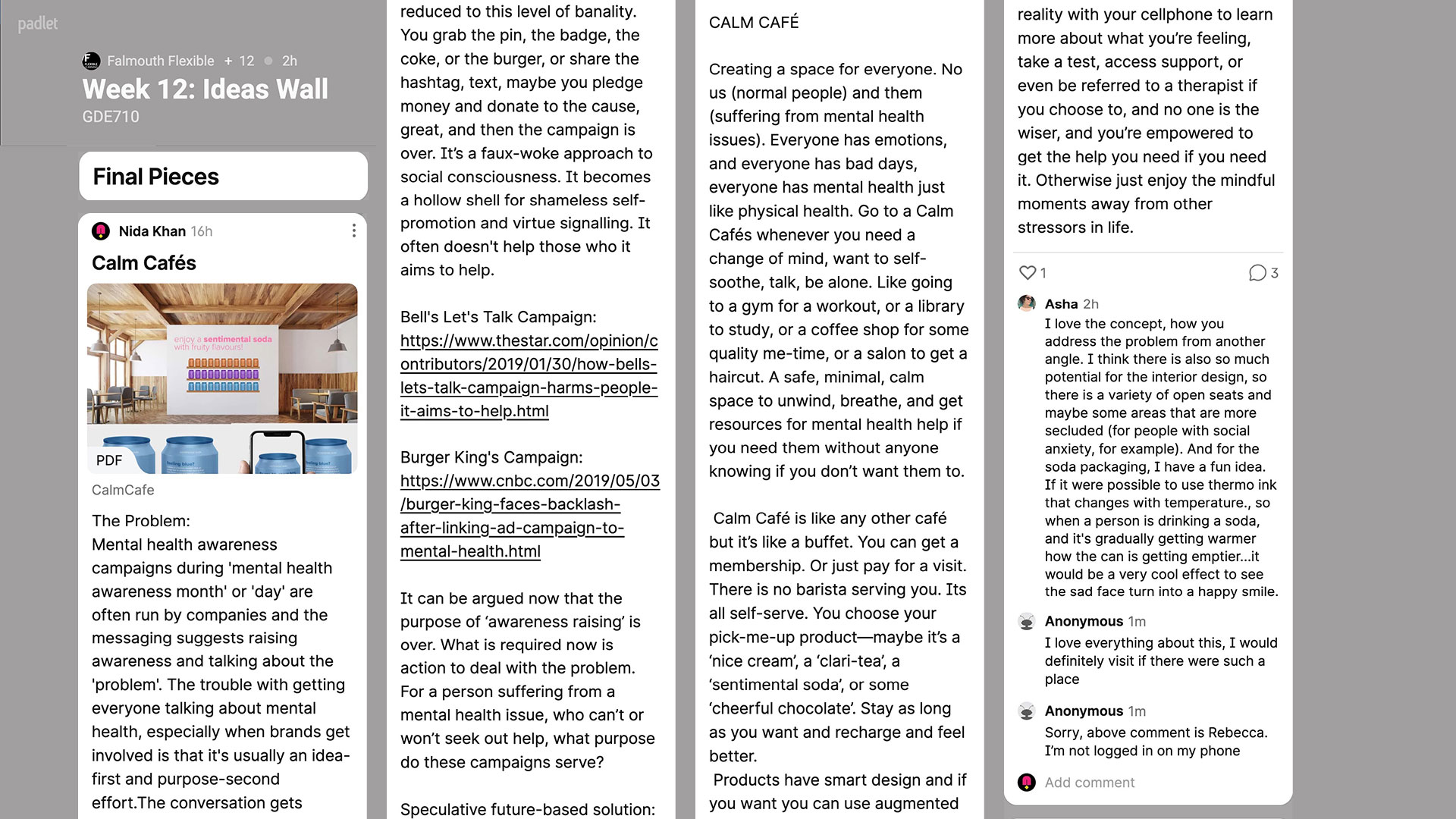
Final thoughts and reflection
This week was a rush to complete the challenge as I was also getting the PDF ready for submission. I think I did the challenge in a hurry so put it together a bit loosely, if I had more time I would do a better job, create a proper storefront of the idea. I used a stock photo for the café and didn't spend as much finesse on the layout of the products. I didn't spend time illustrating the face expression and here chose a stock asset as well. Usually I design my own assets and spend time and care and experiment with copy and layout and treatments. I just went with a minimal typographic approach, simply to get it done and do the best to get the idea across. I know I can do a better job, so I guess that's in my space a bit. Overall really happy to have done this course, I learned a lot! Please forgive any typos.
Thank you for taking the time to read this.
© Nida Khan, 2020 — All rights reserved.
Contemporary Practice
Week 1 • Introduction
Week 2 • Industry Today
Week 3 • Fields of Practice
Week 4 • The Self and Identity
Week 5 • Thoughts on Ideas
Week 6 • Noticing the Ignored
Week 7 • Research and Theory
Week 8 • Skills and Making
Week 9 • Message Delivered
Week 10 • Type and Page
Week 11 • Trends and Environments
Week 12 • New Steps
History & Futures
Coming soon...
Studio & Entrepreneurship
Coming soon...
Application & Interaction
Coming soon...